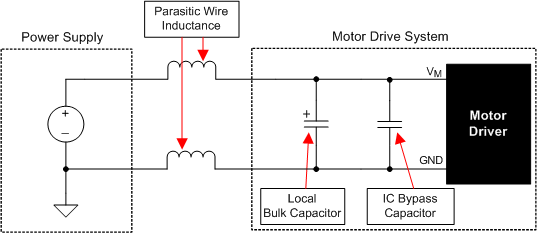SLVSCI2A June 2014 – June 2014 DRV8802-Q1
PRODUCTION DATA.
- 1 Features
- 2 Applications
- 3 Description
- 4 Revision History
- 5 Pin Configuration and Functions
- 6 Specifications
- 7 Detailed Description
- 8 Application and Implementation
- 9 Power Supply Recommendations
- 10Layout
- 11Device and Documentation Support
- 12Mechanical, Packaging, and Orderable Information
Package Options
Mechanical Data (Package|Pins)
- PWP|28
Thermal pad, mechanical data (Package|Pins)
- PWP|28
Orderable Information
9 Power Supply Recommendations
The DRV8802-Q1 is designed to operate from an input voltage supply V(VMx) range between 8.2 and 45 V. Two 0.1-µF ceramic capacitors rated for V(VMx) must be placed as close as possible to the VMA and VMB pins respectively (one on each pin). In addition to the local decoupling caps, additional bulk capacitance is required and must be sized accordingly to the application requirements.
9.1 Bulk Capacitance
Bulk capacitance sizing is an important factor in motor drive system design. It is dependent on a variety of factors including:
- Type of power supply
- Acceptable supply voltage ripple
- Parasitic inductance in the power supply wiring
- Type of motor (Brushed DC, Brushless DC, Stepper)
- Motor startup current
- Motor braking method
The inductance between the power supply and motor drive system will limit the rate current can change from the power supply. If the local bulk capacitance is too small, the system will respond to excessive current demands or dumps from the motor with a change in voltage. You should size the bulk capacitance to meet acceptable voltage ripple levels. The datasheet generally provides a recommended value but system level testing is required to determine the appropriate sized bulk capacitor.
 Figure 10. Example Setup of Motor Drive System WIth External Power Supply
Figure 10. Example Setup of Motor Drive System WIth External Power Supply
9.2 Power Supply and Logic Sequencing
No specific sequence exists for powering-up the DRV8802-Q1 device. Digital input signals can be present before V(VMx) is applied. After V(VMx) is applied to the DRV8802-Q1 device, it begins operation based on the status of the control pins.